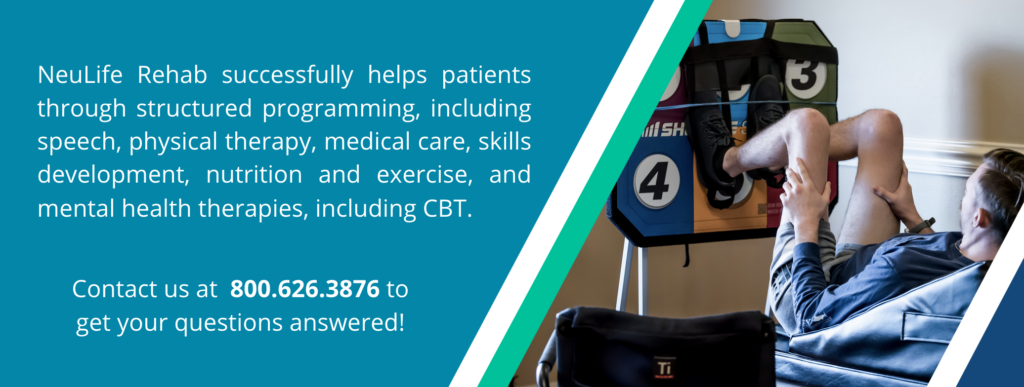Physicians cannot cure many neurological disorders, but rehabilitation can assist in treating symptoms and the restoration of daily functioning.
NeuLife provides individualized therapy to help patients experiencing neurological disorders such as Parkinson’s disease, cerebral Palsy, and amyotrophic lateral sclerosis (Lou Gehrig’s disease) achieve the highest quality of life.
Before we explore the most common neurological conditions that require lifelong care, let’s look closely at the nervous system.
The nervous system is a complex, sophisticated system that regulates and coordinates the body’s activities.
There are two parts to the nervous system:
In addition to the brain and spinal cord, the nervous system's principal organs include the eyes, ears, sensory organs of taste, sensory organs of smell, sensory receptors located in the skin, joints, muscles, and other parts of the body.
Disorders of the nervous system may include the following:
such as stroke, transient ischemic attack (TIA), subarachnoid hemorrhage, subdural hemorrhage and hematoma, and extradural hemorrhage
such as meningitis, encephalitis, polio, and epidural abscess
such as a brain or spinal cord injury, Bell’s Palsy, cervical spondylosis, carpal tunnel syndrome, brain or spinal cord tumors, peripheral neuropathy
such as headache, epilepsy, dizziness, and neuralgia
such as Parkinson’s disease, multiple sclerosis, amyotrophic lateral sclerosis (ALS), Huntington’s chorea, and Alzheimer’s disease
We are now going to discuss some of the most common neurological disorders that require life long care at a neuro rehabilitation center.
Cerebral Palsy (CP) is a group of disorders that affect a person’s ability to move and maintain balance and posture. Cerebral means connection to the brain, and Palsy means weakness or problems with using the muscles.
CP is caused by abnormal brain development or damage to the developing brain that affects a person’s ability to control their muscles. It is considered the most common motor disability in childhood.
The symptoms of CP vary. A person with severe CP might not be able to walk at all or may need to use special equipment to walk.
A person with mild CP, on the other hand, may walk awkwardly but might not need additional help.
CP does not get worse over time, though the exact symptoms can change. Many people suffering from CP also have related conditions such as intellectual disabilities, seizures, and speech limitations.
There is no cure for CP but rehabilitation can improve a person’s condition.
Treatment may include physical, occupational, or speech therapy and medicines to control seizures, relax muscle spasms, and relieve the pain.
Braces and other orthotic devices, wheelchairs and rolling walkers, and communication aids can support the fight with CP.
Amyotrophic lateral sclerosis, also known as Lou Gehrig’s disease, refers to a group of progressive neurological disorders that cause dysfunction in the nerves that control muscle movement.
It attacks the nerve cells known as motor neurons that are used involuntary muscle actions.
In ALS, the motor neurons degenerate or die and stop sending messages to the muscles. Unable to function, the muscles gradually weaken, start to twitch (called fasciculations), and waste away (atrophy).
Eventually, the brain loses its ability to initiate and control voluntary movements.
Early symptoms of ALS include muscle weakness or stiffness.
Gradually all muscles under voluntary control are affected, and individuals lose strength and the ability to speak, eat, move, and even breathe. External support becomes inevitable.
There is currently no cure, so treatment aims to relieve symptoms, provide social and emotional support, and possibly slow disease progression.
Parkinson’s disease (PD) is a long-term degenerative disorder of the central nervous system that affects the motor system. It happens when nerve cells in the brain don’t produce enough of a brain chemical called dopamine.
Sometimes it is genetic, but most cases do not seem to run in families.
Exposure to chemicals in the environment might play a role. Symptoms begin gradually, often on one side of the body; later, they affect both sides. Symptoms include:
As symptoms worsen, people with the disease may have trouble walking, talking, or doing simple tasks. They may also have depression and difficulty sleeping, chewing, swallowing, or speaking.
There is no lab test for PD, so it can be challenging to diagnose. Doctors use a patient’s medical history and a neurological examination to assess symptoms indicating PD.
PD usually begins around age 60, but it can start earlier. It is more common in men than in women. Unfortunately, there is no cure for PD. Surgery and deep brain stimulation (DBS) can help in severe cases, but they are controversial
Therefore acceptance of the gradual loss of independence can be beneficial, along with support for both the patient and family. Being well informed about the disease can reduce anxiety about what lies ahead.

NeuLife is a Residential Post-Acute Rehab facility specializing in neurological disorder rehabilitation and rehab for brain injury.
We treat a range of brain injury disorders, some life long, as well as a focus for post acute brain injury rehabilitation. Our programs may include:
If you would like more information about NeuLife Rehabilitation Services, please contact us.
The material contained on this site is for informational purposes only and DOES NOT CONSTITUTE THE PROVIDING OF MEDICAL ADVICE, and is not intended to be a substitute for independent professional medical judgment, advice, diagnosis, or treatment. Always seek the advice of your physician or other qualified healthcare providers with any questions or concerns you may have regarding your health.

We know that choosing the next step in your recovery from a catastrophic illness or injury is complex. Together, we can help you take the next step.
Contact us with any questions today.